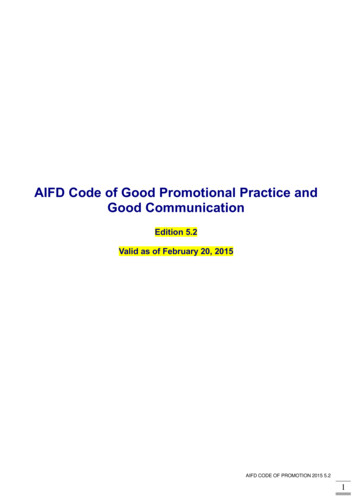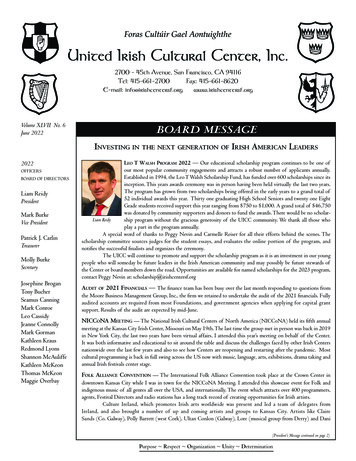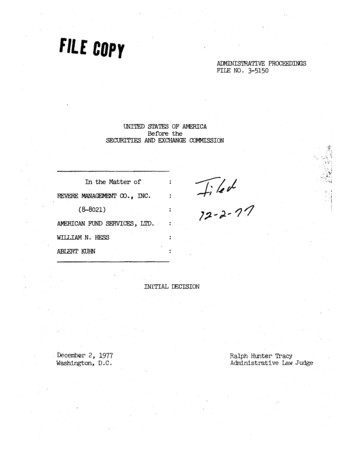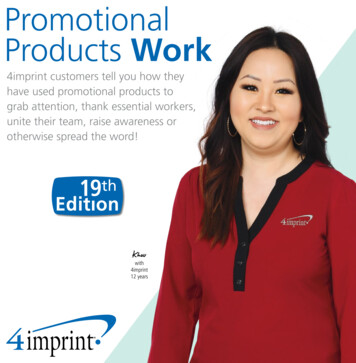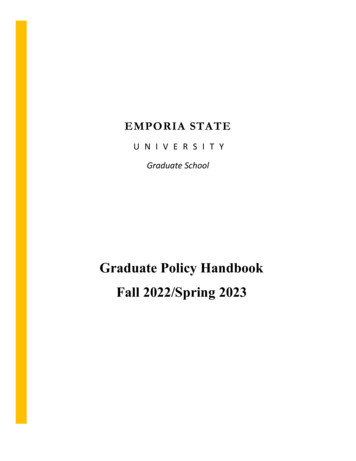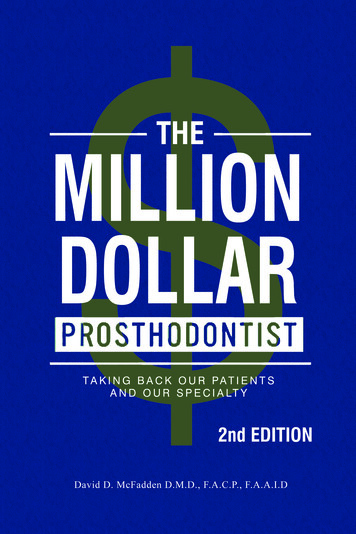
Transcription
TheMillionDollarProsthodontistDavid D. McFaddenD.M.D., F.A.C.P., F.A.A.I.DPennington PublishingDALLAS2017
Copyright 2017 by David D. McFaddenAll rights reservedFor information about permission to reproduce selections fromthis book: write to Permissions, McFadden Dental Implant Center,5120 West Lover’s Lane, Dallas, Texas 75209Visit our Web site: www.dentalimplantcenter.comLibrary of Congress Cataloging-in-Publication DataMcFadden, David D.Million Dollar Prosthodonist / David D. McFaddenIncludes bibliographical references and indexISBN-10: 0-9630418-1-9ISBN-13: 978-0-9630418-1-41. Prosthodontics--Dentistry. 2. Practice Building3. Practice Advertising. I. TitlePrinted in the United States of America10 9 8 7 6 5 4 3 2 1CONTRIBUTORSChristopher BonnerAlan ParadisBob SeedsDonna SeedsBarbara ParadisStaci AshcraftKristi Tomlinson EdstromTammy LancasterPenny BelserAUTHOR’S NOTEIn order to protect their privacy, the names and certain identifyingcharacteristics of all of the patients whose medical histories are describedin this book have been changed.The views and opinions expressed in this book are those of the author and do notreflect the view of the American Dental Association (ADA), the American Collegeof Prosthodontics (ACP), the American Board of Prosthodontists (ABP), the American College of Prosthodontists Educational Foundation (ACPEF), the AmericanAcademy of Implant Dentistry (AAID), the American Board of Oral Implantology(ABOI) or any affiliated associations.
If you want something you’ve never had, you mustdo something you’ve never done!IntroductionPrivate-practice prosthodontists are fighting for survival. Ordinary dentists, many unethically masquerading as prosthodontists, are holding on to cases that should be handed overto specialists. Some prosthodontists have surrendered and becomefull-time academics or insurance-accepting general dentists. Othersare staring at the telephone and waiting for it to ring.The federal government lifting the ban on advertising by medical and dental professionals blew the doors off the referral modelfor specialty dentistry. Before marketing entered into the equation,dentists filled cavities, took X-rays, performed cleanings and occasionally fashioned a crown, dentures or a simple bridge. Dentiststraditionally referred complex cases, more than one crown, andambitious restorations, to a prosthodontist.The prosthodontist did the restoration and then cheerfullyreturned the patient to the referring dentist. Prosthodontists rarelyattempted run-of-the-mill fillings and cleanings. Historically, oneof the benefits of specialization is being liberated from humdrumdentistry.With aggressive marketing, dentists began inflating credentialsand creating phony, confusing “specialties” to capture high-dollarprocedures that formerly belonged to specialists. Ordinary dentistsare convincing the public that they are as qualified as prosthodon3
tists, endodontists, periodontists and orthodontists who spend twoto four years in specialized training beyond dental school.How many of the 1,700 private-practice prosthodontists cancompete successfully with 180,000 general dentists nationwidewho are flooding broadcast, web, and print channels with messages boasting of their expertise in “pretend” specialties? Even someof the non-recognized areas of interest offer a board process thatalmost none of the members challenge. The most common fraudulent specialties include:Cosmetic DentistrySedation DentistryReconstructive DentistryGeriatric DentistryFamily DentistryNeuromuscular DentistryCertain dentists and their sponsoring organizations haveused the legal process to prevent enforcement of laws limitinghow “specialists” can advertise their services. Essentially, thedentists and their organizations contended that the state couldnot limit their First Amendment right to advertise a specialtybestowed in an area not recognized as a specialty by the ADA.The Fifth Circuit Court of Appeals agreed and ruled that lawslimiting dentists from advertising a specialty in areas other thanthose recognized by the ADA are unconstitutional. Effectively,this ruling means that many dentists who are not board-certified in recognized specialties can claim to be a “specialist” in anarea that is descriptively misleading. Unfortunately, in the end,patients may be misled into thinking they are selecting a prosthodontist when they are, in fact, hiring an “Implant Specialist”who is typically not as well-trained in the area as a board-certified prosthodontist.4
INTRODUCTIONOf the nine specialties recognized by the American Dental Association, prosthodontics unquestionably is the most obscure. Lowvisibility has been a chronic problem for prosthodontists since theday the specialty was born 50 years ago.All prosthodontic interest groups have failed to address the specialty’s low visibility and have been astonishingly slow at responding to opportunities to raise it. Implant dentistry and cosmeticdentistry should be synonymous with prosthodontics. Instead, anydentist may lay claim to these terms, always at the expense of prosthodontists and, many times, at the cost of his or her patients.Because many ordinary dentists act as if they are as qualified asprosthodontists, rarely will a consumer hear the word “prosthodontist”coming from a dentist’s lips. The multi-million dollar Clear Choiceadvertising campaign has done more over the last 10 years to makeconsumers aware of prosthodontists than have all of the prosthodonticassociations combined over the last 46 years. Ironically, Clear Choice isthe mortal enemy of private practice prosthodontists.Private practitioners sink or swim based on how credibly theirbrand resonates with consumers. Unfortunately, marketing andcommunications strategies and practice management models arenot taught in dental schools or specialty training.I must admit, even with the printing of The Million DollarProsthodontist, 1st Edition, in 2011, I had not been a good or evenaverage business manager. At that time, success came through adysfunctional work ethic and some fairly bold marketing. I wasvery effective in getting new patients in the door, but I did nothave the staff in place nor the understanding of the numbers toadvise anyone on how to change their bottom line effectively.Since 2012, I have assembled an amazing staff and become a real“manage by the numbers” business owner. Chapter 3, the “numbers,” grew from 4 pages to more than 47. This growth representsthe difference between knowing practically nothing about thebusiness of dentistry to knowing almost everything. It took mefive years. I hope it takes you less!5
MILLION DOLLAR PROSTHODONTISTEverything I have discovered about branding, marketing, communications and practice management has been captured in T heMillion Dollar Prosthodontist, 2nd Edition. These lessons learned in a27 year career have made the McFadden Dental Implant Center, inbrutally competitive Dallas, a multi-million dollar solo practice, basedon a 30 hour work week. This approach is battle-tested, straightforwardand ethical. Some, if not most, of the recommendations will help youbuild a thriving, lucrative practice. Our biggest hurdles, as dentists,are that we are handicapped by closed minds and inflated egos. Theprimary requirement for success is an open mind and a willingnessto learn.6
Someone is sitting in the shade today becausesomeone planted a tree many years ago.- Warren BuffetPreambleThe prosthodontic practices that I attempt to describe anddemonstrate in this book are those at the top when it comesto quality outcomes. These practices should also be at thetop of the earning percentiles but often are not. Because we routinely deliver the best outcomes in dentistry, our income should be inthe top percentiles. It is my hope that this book and the associatedtechniques will help you close the outcome vs. income gap that hasplagued prosthodontists since our inception.Before we begin the discussion of how to build a platinum levelpractice, I would like to explain one of the main themes to whichI will often refer, the bell-shaped curve. Though more boring thanorganic chemistry class, the Bell Curve Book, written in 1994 byHarvard psychologist Richard J. Herrnstein (deceased before thebook was released) and American Enterprise Institute political scientist Charles Murray, has shaped my belief system when it comesto evaluating human performance.7
MILLION DOLLAR PROSTHODONTISTFigure A.1. The Bell Curve evaluates human performance.The book is incredibly well-written. Because the authors knew itwould be wildly controversial, they offer up a plethora of substantiating evidence before, during, and after each section. Its centralargument is that intelligence is substantially influenced by both inherited and environmental factors and is a better predictor of manypersonal dynamics, including financial income, job performance,the chance of unwanted pregnancy, and involvement in crime thanare an individual's parental socioeconomic status or educationallevel. The book also argues that those with high intelligence, the“cognitive elite,” are becoming separated from those of average andbelow-average intelligence and that this is a dangerous social trend8
PREAMBLEwith the United States moving toward a more divided society similar to that in Latin America.Bell-shaped curve (definition) – a symmetrical curve representing the normal distribution. The term “bell curve” comes from thefact that the graph used to depict a normal distribution consists of abell-shaped line.A bell curve is also a useful tool when attempting to understandwhy some individuals can or cannot accomplish certain tasks. Ofcourse, the bell-shaped curve exists when measuring hand skills,speaking skills, sales acumen, crown preparations, running speed,jumping, and any other job or task that can be measured. Thoughit sounds harsh, if you have staff members that continually underperform there are only two explanations: laziness or low IQ. Nomatter which explanation you choose to accept, they do not belongon your team. Below is the standard bell-shaped curve that is alsoknown as “normal distribution.”In this case, it shows the normal distribution of IQ throughoutthe human population. My point about the bell-shaped curve isthat we want our practices, labs, and employees to fall in the sec-Figure A.2. Bell curve showing IQ score distribution9
MILLION DOLLAR PROSTHODONTISTond standard deviation to the right of the mean. Consider thiscurve and where individuals fall on it when evaluating businessrelationships that directly affect the way your practice is perceived,the way you are personally perceived, your income, your happinessand your quality of life. The actual rating of each of those facets ofyour practice is very subjective. I would advise you to trust yourgut instinct while being painfully honest about how you rate everyone and everything directly and indirectly related to your practice.Many of us are not capable of this type of evaluation. Some of usallow emotion to enter into the evaluation process or we simply areunable to evaluate our employees, our labs or even ourselves objectively. For many of us, hiring a consultant is necessary.If the percentile concept works better for you, then your practice and attitude towards it should strive to be in the 95th percentile or higher. To build a platinum level practice where you willbe fulfilled in your work and personal life, you must strive to bein these top percentiles. The phrase, “There is always room at thetop,” applies here.10
ABOUT THE AUTHORDavid McFadden, the son of a Pennsylvania steelworker and a grocery store cashier, knew from the age of nine that he wanted to be adentist. He liked working with his hands and observed that dentistsenjoyed a comfortable lifestyle. “In dental school, I discovered thatordinary dentistry was both easy and boring,” McFadden said. “Thechallenge was missing. I decided to specialize.”McFadden received his dental degree from the University ofPittsburgh, School of Dental Medicine in 1988. He received hisspecialty certificate in Prosthodontics from Baylor College of Dentistry in 1990. He was awarded board certification by the AmericanBoard of Prosthodontics in 1995. In 2013, he was awarded boardcertification by the American Board of Oral Implantology. For nineyears, Dr. McFadden was a faculty professor at UT SouthwesternMedical Center.He established the Dental Implant Center at UT SouthwesternMedical Center. In 2002, he opened the McFadden Dental ImplantCenter in Dallas, Texas. In addition to dental implant treatment,Dr. McFadden’s private practice offers a wide variety of dental services for adults with complex dental needs.Dr. McFadden lectures locally, nationally and internationally.The low-volume, quality-based office is a state-of-the-art facilitywhere outstanding outcomes are the focus.Contact Information5120 W. Lovers LaneDallas, TX 75209(214) 956-9100
SEARCHING FOR ANSWERS?YOU’LL FIND MOST OF THEM IN THIS BOOK.So, you eagerly accepted your certificate and headed out into the world to buildyour own prosthodontic practice, only to discover that private-practice prosthodontists are fighting for survival. That’s because this specialty is the most obscure of thenine specialties recognized by the American Dental Association.Unfortunately, most prosthodontic interest groups have failed to address thespecialty’s low visibility and have been astonishingly slow at responding to opportunities to raise it. Both implant and cosmetic dentistry should be synonymouswith prosthodontics. Instead, any dentist may lay claim to these terms, always at theexpense of prosthodontists and, many times, at the expense of the patients. Consequently, many patients rarely hear the term “prosthodontist” and they continue tohave procedures performed by ordinary dentists.This book is your guide to overcoming this insurmountable challenge. It is based onthe author’s struggle to help patients identify their need for prosthodontists and hisdetermination to teach himself branding, marketing, communications and practicemanagement. Each chapter identifies the most common weaknesses most prosthodontic practices share while setting a specific course for maximizing your practice’spotential.He shares these lessons with you in a straightforward, ethical, and battle-testedmanner. This second edition is loaded with “manage by the numbers” information.Increase new patient flow, case acceptance and income. All that’s required is anopen mind and a willingness to improve.prosthodonticpracticeconsultants.com(469) 729-7722
this book: write to Permissions, McFadden Dental Implant Center, 5120 West Lover's Lane, Dallas, Texas 75209 Visit our Web site: www.dentalimplantcenter.com Library of Congress Cataloging-in-Publication Data McFadden, David D. Million Dollar Prosthodonist / David D. McFadden Includes bibliographical references and index ISBN-10: 0-9630418-1-9
